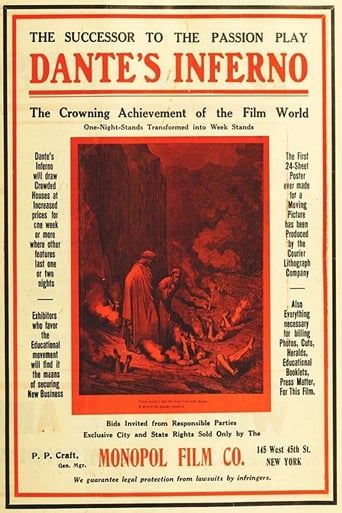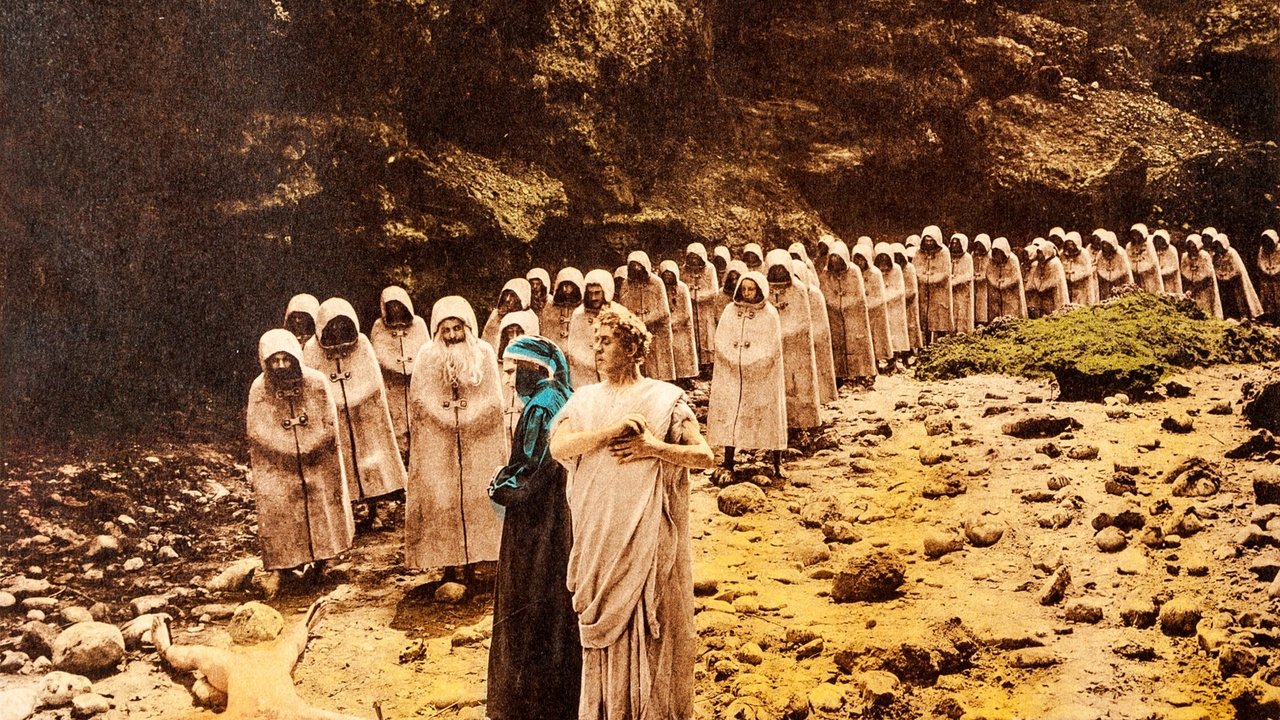leplatypus
I discovered the classic piece thanks to Twin Peaks: a mystery entrance in dark woods, saving love in hell and meeting dead people well alive... Then Dan Brown told his version and it was interesting and the adaptation of his novel was visually powerful. So here one century before, i didn't expected much but after a few minutes, i felt very bored: the captions failed to clearly present the 9 circles and visually they look finally a bit all the same: a river or a beach with naked people agonizing... On the screen, Virgil knows all and is so powerful that we can wonder why he needed Dante anyway.. and by the way, her lover Beatrice appears at the beginning and never happens again as Dante gets out from hell. There is some good costumes and special effects and that was like watching a Star Trek Classic but at the end, we are faraway of the power of words and art from Gustave Doré that inspired the movie.
aplord
Yes, it's important as an very early feature film that actually survives in something like its original form (the loss of much of a film t like The Kelly Gang is a tragedy) but L'inferno is pretty primitive.The story telling technique consists of an inter-title telling us what we're about to see, followed by a static shot showing it to us. The acting is of the roll your eyes and wave your arms around variety the actor playing Peter of Vigna is so over the top it's an object lesson in overacting) and the actors playing Dante and Virgil are, to put it politely, pretty porky. There are some great images here - the river of filth, filled with the flatterers, a decapitated man, holding his screaming head up high in his hand - but there's quite a bit that's laughable too. Cerberus looks liked a rather friendly three headed alpaca, and the harpies look like something out of a school play. And then there's one of the most inappropriate soundtracks ever imposed on a poor innocent piece of celluloid. Tangerine Dream... really? So as a historical film artifact... worth the watch, but only with the sound down
L B (LbFilmFanatic)
A celluloid of wonder; When this movie was made, its Box Office Revenue reached 2 Million Dollars after it's premiere. It was made in 1910, released in Italy, and slowly hoisted itself into a larger audience, which ultimately lead to it being successful, financially and palatable enough to an audience subsequently dispersing around the world of the rather premature cinema in that time. It's pretty hard to believe with any sense of incredulity that this movie is so eidetic in it's own quality of imagery - of course, iconography is out of date, such as the spirits of Cleopatra, Seances and The Spirits that float around, but this is actually what makes the movie great, due to how adroit they were in crafting the paradigms of surrealism (essentially just expressionism) and so forth in our minds of how we react to this and how we assimilate it.I think what really entices me is the animatronics of Lucifer, the motifs of such things like the pride, avarice and lust all reflected in the form of animals (of course, not arbitrarily, but rather how it is codified, I believe that to be the case), the alchemy of an individual that is to be enough to immortalise her - Ergo, the inferno.Plot is really austere (but the narrative can actually make you think - it's funny how with movies of this time, it feels more like an actual form of denouement literature, and not like any other box office movie that can be mutilated by its own failure to communicate a story and rather how to show aesthetically, faux and overused concoctions on the screen). The plot centres around a story adapted by Francesco Bertolini, Adolfo Padovan, Giuseppe de Liguoro (who was the one with the most control over the movie, I think) of the Divine Comedy, a story about an allegorical acuity of the afterlife - "To the great beyond avoiding heaven" - Dante is on a quest to try and immortalise a potent 9 year old. He finds Virgil, a roman poet, who accompanies him through the trails of hell, the punishment of people - or rather ones who are under a despot's appetency for a lack of hope. The movie takes you through the dehumanising effects of these situations in kind of a vivacious way.There are problems like: You never get to understand why there was even introductions to avarice, pride and lust (of course, I feel this is just an ad hominem attack at it, but it just came to me like it was kind of off and dispensable to say the least)I can say briefly: This movie was just so fascinating! It's became an entity out of it's own acclaim in cinema, notwithstanding it's endowment of such methodology in cinema like: Tableaux framing, ambient lighting, anecdotal characters (Dante, The Men of Science, Bishop, Virgil - more even then that. The acting is kind of what can poise your understanding of what you're watching, but the odyssey works with how they interact with the out of body world; there is even slight scenes of nudity (some have said it's the first movie to really have this in it, which may not say a lot, but it actually does lampshade it's age, as you can see)"Mastiffs and Harpes leather "thongs"" - The language now, the metric system was back then used as to define "whips", which is another thing that I gleaned on this movie with the terse ways of speaking at that time. "Hell is ultimatum" - this quote alone reverberates the shear theme of the movie.The movies best parts for me involve the way in which smoke is utilised in order to become more transcendental in to the residing form of our normal world. The way in which Dante and Virgil feel like they're almost in a daze - Benign in even the most out of proportion places at once within hell, like a exploration and they're in the same perspective as the audiences - maybe even the emotive side to both hate, endurance and marvel - if you notice the girth of their ground is always higher then the ones underground like a metaphor for heaven and hell. There is so much to cover with this movie, but we cannot look at this movie in the context of this epoch, as it falls flat ultimately. It is a more a look into the depths of what we don't know, fantastically, and also what we didn't know has became a hybrid of elements in which movies nowadays have borrowed or shoehorned into movies.The movie in itself probably receives 7 on the radar, whereas the resonance of its importance ranks that up to a 9/10 (possible 10).
paulnewman2001
A striking piece of history, this 1911 adaptation of Dante's The Divine Comedy was the first full length feature made in Italy.Taking visual inspiration from Gustav Doré's iconic illustrations, Giuseppe de Liguoro worked for more than three years with 150 people and what was then the biggest film budget ever to complete his masterpiece.Newly restored from a variety of sources, it's still an amazing visual experience as the poet Virgil leads Dante on a journey through Purgatory and Hell.L'Inferno's pantheon of demons and sinners are imaginatively conjured up on ambitious sets using a variety of then-pioneering cinematic tricks such as forced perspective to allow a gigantic Pluto to rage at the dwarfed interlopers, overlays for when they arrive at the city of Dis and see furies scaling the battlements and an ingenious combination of miniatures and live action to create remarkable encounters with three chained giants and a final confrontation with Lucifer himself.In between these set pieces, Dante and his guide meet a rogues gallery of history's great sinners and the ironically apposite corners of Hell reserved just for them.The only real pitchfork in the backside of this otherwise commendable project is the decision to harness the visuals to a soundtrack culled from Tangerine Dream's concept album based on the same literary source.It's not the German electronic outfit's best work and comes with the additional burden of vocals which tend to detract from the Gothic mood created by the visuals alone.Still, you can always turn down the sound and play something more sympathetic, say, Bartok's Concerto For Orchestra, because this is one screen gem that deserves to be enjoyed several times over.


 AD
AD


